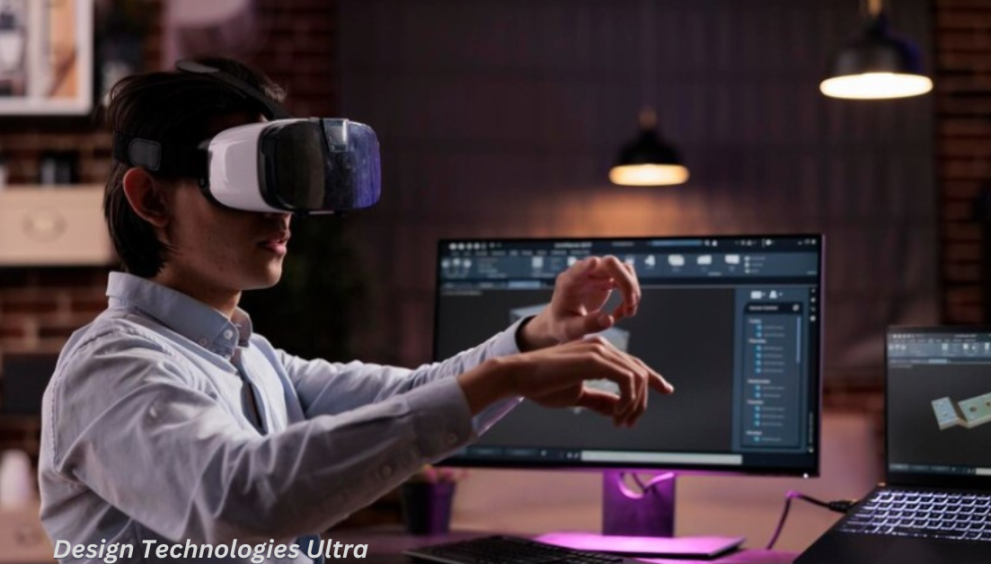Design Technologies Ultra: Revolutionizing the Future of Design

The world of design is evolving at an unprecedented pace. As technological advancements accelerate, so does the need for innovative tools, methods, and platforms that streamline the creative process and deliver next-level results. One name that stands out in this fast-moving landscape is Design Technologies Ultra. But what exactly is it, and how is it changing the future of design? Let’s dive deep into the impact of Design Technologies Ultra and how it’s shaping the industry for creators, brands, and consumers alike.
What is Design Technologies Ultra?
Design Technologies Ultra refers to the cutting-edge techniques and tools that are pushing the boundaries of traditional design. From AI-driven systems to virtual reality and 3D modeling, the platform is designed to enhance creativity, boost efficiency, and allow designers to realize concepts that once seemed impossible.
These technologies span a wide range of disciplines—from graphic design and product design to architecture and fashion design. Whether you’re designing websites, animations, physical products, or interactive spaces, Design Technologies Ultra offers a comprehensive suite of tools that helps you create better, faster, and more intelligently.
Key Features of Design Technologies Ultra
- AI-Powered Design Tools: Automation meets creativity with AI-driven tools that predict, optimize, and suggest design elements.
- 3D and Virtual Reality: Advanced rendering and modeling capabilities for an immersive design experience.
- Collaboration Platforms: Seamless integrations for team collaboration, making design a more interactive and cohesive process.
- Sustainability Focus: Tools that incorporate eco-friendly practices, ensuring that designs have minimal environmental impact.
- Rapid Prototyping: Faster iterations and tangible prototypes to move ideas from concept to production swiftly.
The Core Pillars of Design Technologies Ultra
To better understand the impact of Design Technologies Ultra, it’s essential to break it down into its core pillars: creativity, efficiency, collaboration, and sustainability. Each pillar plays a vital role in the overall evolution of the design process.
Creativity: Unlocking New Horizons
The first pillar is creativity, which remains at the heart of any design process. What makes Design Technologies Ultra so revolutionary is its ability to expand the creative potential of designers. By leveraging AI algorithms, designers are no longer constrained by their own technical limitations. The system can suggest color palettes, fonts, layouts, and even design structures, reducing the amount of time spent on the brainstorming process while enhancing overall creativity.
AI-Driven Creativity
The introduction of AI into the design world allows for more imaginative and unique outputs. Whether you’re designing an interface for an app or creating a new product line, the AI in Design Technologies Ultra can analyze trends, predict consumer preferences, and even help you come up with entirely new design concepts. This takes much of the guesswork out of the design process, allowing for greater focus on innovation.
Efficiency: Reducing Time to Market
Another crucial aspect of Design Technologies Ultra is the emphasis on efficiency. In today’s fast-paced world, designers and brands must meet tight deadlines while maintaining high-quality standards. With features like rapid prototyping, AI-powered tools, and integrated workflows, the time from initial concept to final product is dramatically reduced.
The Role of Automation in Design
Automation plays a big role in improving efficiency. By automating repetitive tasks such as resizing images, adjusting layouts, and applying styles across multiple design platforms, designers can focus on more critical aspects of their work. Furthermore, automated testing of design prototypes ensures that flaws and inconsistencies are identified and resolved early in the process.
Collaboration: Bridging the Gap Between Teams
Collaboration is the third pillar of Design Technologies Ultra, addressing one of the most critical challenges in modern design—bringing together different team members, each with their unique skills and insights, to work cohesively toward a common goal.
Enhanced Teamwork Through Integrated Platforms
With collaborative platforms built into the design process, Design Technologies Ultra enables designers, developers, and stakeholders to work together in real-time. This cross-functional collaboration eliminates silos and promotes a culture of transparency and creativity.
Whether teams are working remotely or in-house, these tools allow for instant feedback, version control, and shared access to assets, making collaboration more seamless than ever. This ultimately leads to better, more cohesive design outcomes.
Sustainability: Designing for a Better Tomorrow
One of the most important shifts in recent design trends is the move toward sustainability, and Design Technologies Ultra is at the forefront of this movement. Today, more than ever, consumers are demanding eco-friendly products, and designers need tools that allow them to meet these demands without compromising on creativity or quality.
Eco-Friendly Design Tools
With features that integrate sustainable materials and processes into the design workflow, Design Technologies Ultra helps designers minimize waste, reduce carbon footprints, and create products that are more sustainable. By simulating how materials will behave in the real world, designers can make informed choices that reduce environmental impact.
Moreover, the platform provides analytics on the environmental footprint of each design, allowing for informed decision-making throughout the production process.
Cutting-Edge Tools Driving Design Technologies Ultra
1. Artificial Intelligence (AI) in Design
AI is the driving force behind much of Design Technologies Ultra. By utilizing machine learning, AI helps designers automate mundane tasks, create predictive models, and even enhance aesthetic judgments. Some AI systems are capable of analyzing existing design trends and producing recommendations that align with the user’s objectives.
Predictive Analytics
AI-powered predictive analytics tools can forecast design trends, helping brands stay ahead of the curve. Whether it’s identifying popular colors, materials, or shapes, these tools ensure that designs resonate with current market preferences, making them more likely to succeed.
2. Virtual Reality (VR) and Augmented Reality (AR)
Another game-changing tool within Design Technologies Ultra is the integration of virtual reality (VR) and augmented reality (AR). These technologies allow designers to create immersive experiences that go beyond traditional 2D designs.
Designing in 3D
With VR and AR, designers can create and manipulate 3D models in real-time. This is particularly beneficial in industries such as architecture and product design, where spatial awareness is critical. Designers can view, adjust, and test their creations in a virtual environment before committing to physical prototypes.
3. Blockchain for Secure Design Ownership
With the rise of digital designs and increasing concerns over intellectual property, blockchain technology is becoming an essential tool for ensuring secure ownership of design assets. By using blockchain, designers can protect their creations from unauthorized copying or tampering.
Secure Digital Transactions
Blockchain can also be used for secure, traceable transactions, making it easier for designers to sell or license their work. This provides a level of security and transparency previously unavailable in the design industry.
Real-World Applications of Design Technologies Ultra
1. Product Design: Revolutionizing Prototyping and Manufacturing
One of the areas where Design Technologies Ultra has made the most significant impact is in product design. With faster prototyping, designers can quickly bring concepts to life, iterate multiple times, and refine their products without having to invest in expensive materials or production processes.
Speeding Up Prototyping
Using AI and VR, designers can create prototypes that closely resemble final products in much less time. This accelerated process not only reduces costs but also allows for more experimentation and creative risk-taking.
2. Graphic Design: Streamlining Creative Workflows
Graphic designers are also benefiting from Design Technologies Ultra, especially with tools that automate repetitive tasks. The platform makes it easier for designers to focus on the creative aspects of their work while AI takes care of the tedious tasks, such as adjusting layouts for different devices or platforms.
Consistency Across Platforms
With Design Technologies Ultra, graphic designers can ensure that their work remains consistent across multiple platforms, be it print, digital, or mobile. The system automatically adjusts elements like font size, spacing, and colors to ensure the design maintains its integrity across formats.
3. Architecture and Interior Design: Creating Immersive Experiences
In architecture and interior design, Design Technologies Ultra allows designers to visualize spaces in ways that were previously impossible. VR technology enables clients to walk through a digital version of their future home or office, providing a more immersive experience than traditional blueprints or 2D models ever could.
Virtual Walkthroughs
Designers can create detailed virtual walkthroughs that give clients a real sense of space, scale, and ambiance. This not only helps in making decisions faster but also ensures that the final design meets client expectations.
The Future of Design with Design Technologies Ultra
Looking ahead, Design Technologies Ultra promises to continue evolving. With advancements in AI, VR, AR, and sustainability-focused tools, the platform will keep pushing the boundaries of what’s possible in the world of design.
Personalization Through AI
As AI technology becomes more advanced, we can expect even greater personalization in design tools. Designers will have access to systems that can adapt to their personal style, preferences, and even their level of expertise, making the design process more intuitive and enjoyable.
Expanding Accessibility for Designers Worldwide
Another exciting development is the democratization of design. With the rise of cloud-based design tools, the barrier to entry is lower than ever. Whether you’re an individual creator, a startup, or a large corporation, you’ll have access to the same powerful tools, leveling the playing field and fostering innovation across the globe.
Sustainability as a Standard
Sustainability will also remain a key focus moving forward. As consumers become more environmentally conscious, the demand for sustainable design will grow. Design Technologies Ultra is poised to lead the way in eco-friendly solutions, ensuring that future designs are not only beautiful but also responsible.
Conclusion: Embrace the Future with Design Technologies Ultra
Design Technologies Ultra is more than just a suite of tools—it’s a revolution in the way design is conceptualized, executed, and delivered. By incorporating AI, VR, AR, and a focus on sustainability, it empowers designers to push their creative boundaries, improve efficiency, and collaborate more effectively than ever before.
As we move further into the digital age, embracing technologies like Design Technologies Ultra is essential for anyone looking to stay at the forefront of design innovation. Whether you’re a professional designer or just starting, now is the time to explore the limitless possibilities that these cutting-edge technologies offer.







